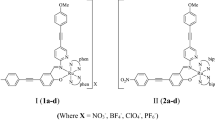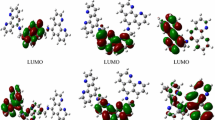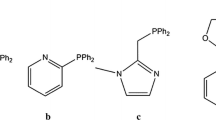Abstract
Reaction of 2-(phenylazo)pyridine (pap) with [Ru(PPh3)3X2] (X = Cl, Br) in dichloromethane solution affords [Ru(PPh3)2(pap)X2]. These diamagnetic complexes exhibit a weakdd transition and two intense MLCT transitions in the visible region. In dichloromethane solution they display a one-electron reduction of pap near − 0.90 V vs SCE and a reversible ruthenium(II)-ruthenium(III) oxidation near 0.70 V vs SCE. The [RuIII(PPh3)2(pap)Cl2]+ complex cation, generated by coulometric oxidation of [Ru(PPh3)2(pap)Cl2], shows two intense LMCT transitions in the visible region. It oxidizes N,N-dimethylaniline and [RuII(bpy)2Cl2] (bpy = 2,2′-bipyridine) to produce N,N,N′,N′-tetramethylbenzidine and [RuIII(bpy)2Cl2]+ respectively. Reaction of [Ru(PPh3)2(pap)X2] with Ag+ in ethanol produces [Ru(PPh3)2(pap)(EtOH)2]2+ which upon further reaction with L (L = pap, bpy, acetylacetonate ion(acac−) and oxalate ion (ox2−)) gives complexes of type [Ru(PPh3)2(pap)(L)]n+ (n = 0, 1, 2). All these diamagnetic complexes show a weakdd transition and several intense MLCT transitions in the visible region. The ruthenium(II)-ruthenium(III) oxidation potential decreases in the order (of L): pap > bpy > acac− > ox2−. Reductions of the coordinated pap and bpy are also observed.
Similar content being viewed by others
References
Bhattacharya S 1993Polyhedron 12 235
Bhattacharya S 1994Polyhedron 13 451
Chakravarty J and Bhattacharya S 1994Polyhedron 13 2671
Chowdhury S, Kakoti M, Deb A K and Goswami S1992Polyhedron 11 3138
Dose E V and Wilson L J 1978Inorg. Chem. 17 2600
El-Hendawy A E, Al-Kubaisi A H, El-Kourashy E G and Shanab M M 1993Polyhedron 12 2343
Galus Z and Adams R N 1962J. Am. Chem. Soc. 84 2061
Galus Z, White R M, Rowland F S and Adams R N 1962J. Am. Chem. Soc. 84 2065
Ghatak N and Bhattacharya S 1994Polyhedron 13 2999
Ghatak N, Chakravarty J and Bhattacharya S1995Trans. Met. Chem. 20 138
Ghosh B K and Chakravorty A 1989Coord. Chem. Rev. 95 239
Goswami S, Chakravarty A R and Chakravorty A 1981Inorg. Chem. 20 2246
Goswami S, Mukherjee R N and Chakravorty A 1983Inorg. Chem. 22 2825
Johnson E C, Sullivan B P, Salmon D J, Adeyemi S A and Meyer T J 1978Inorg. Chem. 17 2211
Kalyanasundaram K 1982Coord. Chem. Rev. 46 159
Krause R A and Krause K 1980Inorg. Chem. 19 2600
Krause R A and Krause K 1982Inorg. Chem. 21 1714
Lahiri G K, Bhattacharya S, Goswami S and Chakravorty A 1990J. Chem. Soc., Dalton Trans. 561
Mercer E E and Buckley R R 1965Inorg. Chem. 4 1692
Mizoguchi T and Adams R N 1962J. Am. Chem. Soc. 84 2058
Sawyer D T and Roberts J L Jr 1974Experimental electrochemistry for chemists (New York: Wiley) pp 167–215
Seddon E A and Seddon K R 1984The chemistry of ruthenium (Amsterdam: Elsevier)
Seddon K R 1981Coord. Chem. Rev. 35 41
Seddon K R 1982Coord. Chem. Rev. 41 79
Seddon K R 1985Coord. Chem. Rev. 67 171
Stephenson T A and Wilkinson G1966J. Inorg. Nucl. Chem. 28 945
Tokel-Takvorian N E, Hemingway R E and Bard A J 1973J. Am. Chem. Soc. 95 6582
Walter M and Ramalay L1973Anal. Chem. 45 165
Wong W T 1994Coord. Chem. Rev. 131 45
Author information
Authors and Affiliations
Rights and permissions
About this article
Cite this article
Chakravarty, J., Bhattacharya, S. Chemistry of ruthenium in N2P2X2 (X = Cl, Br) coordination sphere: Synthesis, characterization and reactivities. Proc. Indian Acad. Sci. (Chem. Sci.) 107, 361–370 (1995). https://doi.org/10.1007/BF02840792
Issue Date:
DOI: https://doi.org/10.1007/BF02840792




